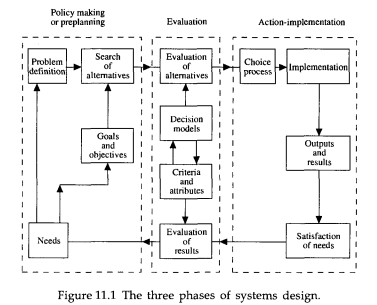Planners and problem solvers dealing with large-scale societal problems have long been aware that their situations are quite different from those of ordinary scientists and engineers. Classical methods of science and engineering have little if any relevance in their work. They are no longer surprised to find that their solutions often induce problems of greater severity than those that they were intended to solve. By nature, social systems are interconnected networks where output from one part becomes input to another, thereby obscuring the determination of where the real problem is situated and how to intervene. It is also said that social systems have no goals to be achieved, rather they have relations to be maintained.
A main determinant for the complexity of large-scale systems is the ever-increasing rate of change in modern society. This in itself adds to the complexity of all problems, which in turn implies more time for their solution. Russell Ackoff (1981) says the following about rate of change: ‘The more the rate of change increases, the more the problems that face us change and the shorter is the life of the solutions we find to them. Therefore, by the time we find solutions to many of the problems that face us, usually the most important ones, the problems have so changed that our solutions to them are no longer relevant or effective; they are stillborn.’
An excellent examination regarding the nature of social problems has been performed by H. Rittel and M. Webber (1974). Their main thesis is that social problems (which they call ‘wicked problems’) are never solved. At best they are only resolved — over and over again. The following main statements are adopted from their work.
• There is no definitive formulation of a wicked problem
The formulation of a wicked problem is the problem! Finding the problem is the same thing as finding the solution.
• Wicked problems have no stopping rule
The problem solver terminates the work for reasons external to the problem. He runs out of time, money or patience.
• Solutions to wicked problems are not true or false, but good or bad
Many parties have equal rights to judge the solutions.
• There is no immediate nor ultimate test of a solution to a wicked problem
Consequences of the solution may yield utterly undesirable repercussions which outweigh the intended advantages. The full consequences cannot be appraised until the waves of repercussions have completely disappeared.
• Every solution to a wicked problem is a one-shot operation with no opportunity to learn by trial and error
Every implemented solution is consequential. Large public works are effectively irreversible; you cannot build a freeway to see how it works and then easily correct it afterwards. The effects of an experimental curriculum will follow the pupils into their adult lives.
• Wicked problems do not have a defined set of potential solutions, nor is there a well-described set of permissible operations to use
There are no criteria which enable one to prove that all solutions have been identified and considered. Which of the solutions should be pursued is only a matter of opinion.
• Every wicked problem is essentially unique
There are no classes of wicked problems such that principles of solutions can be developed to fit all members of the class. Every situation is likely to be one of a kind.
• Every wicked problem can be considered to be a symptom of another problem
Problems can be described as discrepancies between the state of affairs as it is and the state as it ought to be. Removal of the cause poses another problem of which the original problem is a symptom. The higher the level of a problem’s formulation, the broader and more general it becomes and the more difficult it becomes to do something about it. The level at which a problem is settled depends upon the problem-solver and cannot be determined on logical grounds. However, one should not try to cure symptoms; one should try to settle the problem at as high a level as possible.
• A wicked problem can be explained in numerous ways. The choice of explanation determines the nature of the problem’s resolution
Crimes in the street can be explained by not enough police, by too many criminals, by inadequate laws, cultural deprivation, too many guns, etc. Everybody picks the explanation which fits his intentions best. What comprises problem-solution for one is problem-generation for another.

(Reprinted with permission from J.P. van Gigch, Applied General Systems Theory, Harper & Row, 2nd Ed.,1978.)
Source: Skyttner Lars (2006), General Systems Theory: Problems, Perspectives, Practice, Wspc, 2nd Edition.
